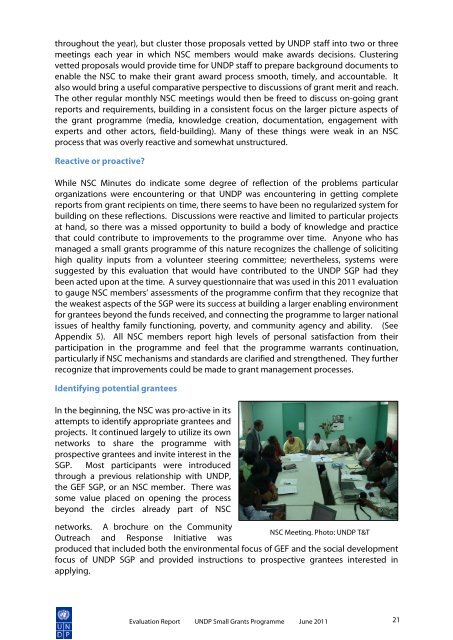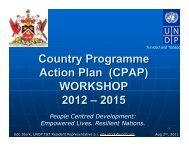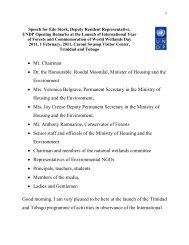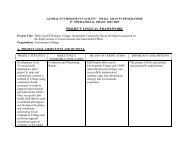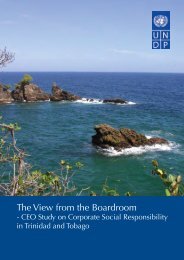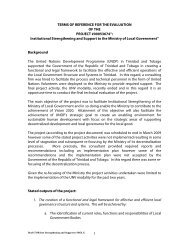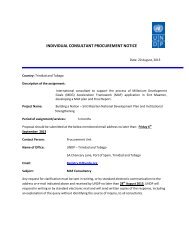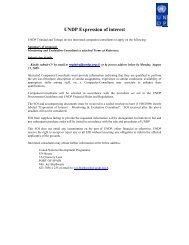UNDP Small Grants Programme Evaluation Report June 2011
UNDP Small Grants Programme Evaluation Report June 2011
UNDP Small Grants Programme Evaluation Report June 2011
Create successful ePaper yourself
Turn your PDF publications into a flip-book with our unique Google optimized e-Paper software.
throughout the year), but cluster those proposals vetted by <strong>UNDP</strong> staff into two or threemeetings each year in which NSC members would make awards decisions. Clusteringvetted proposals would provide time for <strong>UNDP</strong> staff to prepare background documents toenable the NSC to make their grant award process smooth, timely, and accountable. Italso would bring a useful comparative perspective to discussions of grant merit and reach.The other regular monthly NSC meetings would then be freed to discuss on-going grantreports and requirements, building in a consistent focus on the larger picture aspects ofthe grant programme (media, knowledge creation, documentation, engagement withexperts and other actors, field-building). Many of these things were weak in an NSCprocess that was overly reactive and somewhat unstructured.Reactive or proactive?While NSC Minutes do indicate some degree of reflection of the problems particularorganizations were encountering or that <strong>UNDP</strong> was encountering in getting completereports from grant recipients on time, there seems to have been no regularized system forbuilding on these reflections. Discussions were reactive and limited to particular projectsat hand, so there was a missed opportunity to build a body of knowledge and practicethat could contribute to improvements to the programme over time. Anyone who hasmanaged a small grants programme of this nature recognizes the challenge of solicitinghigh quality inputs from a volunteer steering committee; nevertheless, systems weresuggested by this evaluation that would have contributed to the <strong>UNDP</strong> SGP had theybeen acted upon at the time. A survey questionnaire that was used in this <strong>2011</strong> evaluationto gauge NSC members’ assessments of the programme confirm that they recognize thatthe weakest aspects of the SGP were its success at building a larger enabling environmentfor grantees beyond the funds received, and connecting the programme to larger nationalissues of healthy family functioning, poverty, and community agency and ability. (SeeAppendix 5). All NSC members report high levels of personal satisfaction from theirparticipation in the programme and feel that the programme warrants continuation,particularly if NSC mechanisms and standards are clarified and strengthened. They furtherrecognize that improvements could be made to grant management processes.Identifying potential granteesIn the beginning, the NSC was pro-active in itsattempts to identify appropriate grantees andprojects. It continued largely to utilize its ownnetworks to share the programme withprospective grantees and invite interest in theSGP. Most participants were introducedthrough a previous relationship with <strong>UNDP</strong>,the GEF SGP, or an NSC member. There wassome value placed on opening the processbeyond the circles already part of NSCnetworks. A brochure on the CommunityNSC Meeting. Photo: <strong>UNDP</strong> T&TOutreach and Response Initiative wasproduced that included both the environmental focus of GEF and the social developmentfocus of <strong>UNDP</strong> SGP and provided instructions to prospective grantees interested inapplying.<strong>Evaluation</strong> <strong>Report</strong> <strong>UNDP</strong> <strong>Small</strong> <strong>Grants</strong> <strong>Programme</strong> <strong>June</strong> <strong>2011</strong>21


